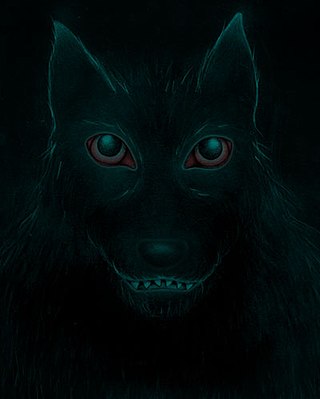Related Research Articles

In South Jersey and Philadelphia folklore in the United States, the Jersey Devil is a legendary creature said to inhabit the forest of Pine Barrens in South Jersey. The creature is often described as a flying biped with hooves, but there are many variations. The common description is that of a bipedal kangaroo-like or wyvern-like creature with a horse- or goat-like head, leathery bat-like wings, horns, small arms with clawed hands, legs with cloven hooves, and a forked tail. It has been reported to move quickly and is often described as emitting a high-pitched "blood-curdling scream".

The Bogeyman is a type of mythic creature used by adults to frighten children into good behavior. Bogeymen have no specific appearance and conceptions vary drastically by household and culture, but they are most commonly depicted as masculine or androgynous monsters that punish children for misbehavior. The Bogeyman or conceptually similar monsters can be found in many cultures around the world. Bogeymen may target a specific act or general misbehaviour, depending on what purpose needs serving, often on the basis of a warning from the child's authority figure. The term is sometimes used as a non-specific personification or metonym for terror, and in some cases, the Devil.

In English folklore, Black Shuck, Old Shuck, Old Shock or simply Shuck is the name given to a ghostly black dog which is said to roam the coastline and countryside of East Anglia, one of many such black dogs recorded in folklore across the British Isles. Accounts of Black Shuck form part of the folklore of Norfolk, Suffolk, the Cambridgeshire Fens and Essex, and descriptions of the creature's appearance and nature vary considerably; it is sometimes recorded as an omen of death, but, in other instances, is described as companionable.

Mujina is an old Japanese term primarily referring to the Japanese badger, but traditionally to the Japanese raccoon dog (tanuki), causing confusion. Adding to the confusion, it may also refer to the introduced masked palm civet, and in some regions badger-like animals or Japanese raccoon dog are also called mami.

A hellhound is a mythological hound that embodies a guardian or a servant of hell, the devil, or the underworld. Hellhounds occur in mythologies around the world, with the best known examples being Cerberus from Greek mythology, Garmr from Norse mythology, the black dogs of English folklore, and the fairy hounds of Celtic mythology. Physical characteristics vary, but they are commonly black, anomalously overgrown, supernaturally strong, and often have red eyes or accompanied by flames.

A werecat is an analog to "werewolf" for a feline therianthropic creature.

The church grim is a guardian spirit in English and Nordic folklore that oversees the welfare of a particular Christian church, and protects the churchyard from those who would profane and commit sacrilege against it. It often appears as a black dog but is known to take the form of other animals. In modern times, when black dogs are kept as pets in churches and their attached parsonages, these are called church grims since they reside on and guard ecclesiastical property.

Were-hyena is a neologism coined in analogy to werewolf for therianthropy involving hyenas. It is common in the folklore of the Arabian Peninsula, the Levant, North Africa, the Horn of Africa, and the Near East as well as some adjacent territories. Unlike werewolves and other therianthropes, which are usually portrayed as being originally human, some werehyena lore tells of how they can also be hyenas disguised as humans.

Nicholas Redfern is a British best-selling author, journalist, cryptozoologist and ufologist.
A jenglot is a small creature of Indonesian culture and mythology. It has the appearance of a deformed humanoid doll and whose size is up to 12 centimetres (4.7 in) in length. They have long hair which grows sparse and stiff through the legs, and long nails. The doll itself does nothing, but when imbued with black magic, is said to provide protection to its master, takes revenge on an enemy or works as a good luck charm. It can fetch thousands of ringgit when sold.

The black dog is a supernatural, spectral, or demonic entity originating from English folklore that has also been seen throughout Europe and the Americas. It is usually unnaturally large with glowing red or yellow eyes, is often connected with the Devil, and is sometimes an omen of death. It is sometimes associated with electrical storms, and also with crossroads, barrows, places of execution and ancient pathways.
Mythic humanoids are mythological creatures that are part human, or that resemble humans through appearance or character. Each culture has different mythical creatures that come from many different origins. A major chunk of these creatures are humanoids. They are often able to talk and in many stories they guide the hero on their journey. They are said to come before the creation of gods and goddesses.
References
- 1 2 Wentworth Day, James (1954). Here Are Ghosts and Witches. B.T. Batsford.
- 1 2 Codd, Daniel (2010). "The Weird Animal Kingdom: Black Shuck and Other Phantom Animals". Mysterious Cambridgeshire. JMD Media. ISBN 9781859838082.
- ↑ Harries, John (1968). The Ghost Hunter's Road Book. Muller.
- 1 2 Ash, Russell (1973). Folklore, Myths and Legends of Britain. Reader's Digest.
- 1 2 Howat, Polly (1990). Tales of Old Cambridgeshire. Countryside Books. ISBN 9781853060861.